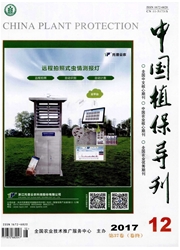

 中文摘要:
中文摘要:
2002~2004年对湖南省湘阴县藠头—水稻轮作模式和西瓜—水稻镶嵌种植模式示范基地的稻田蜘蛛进行实地调查,分析了这2种水稻种植模式中蜘蛛群落结构和季节消长动态。结果表明,西瓜—水稻模式田的物种丰富度(44)及多样性指数(4.25954)最高;其次为藠头—水稻模式田,其物种丰富度为41、多样性指数为4.21310;最低的是常规的双季早、晚稻田,早、晚稻的物种丰富度分别为38和32,多样性指数分别为4.11054和3.94763。说明采用前2种稻田种植模式。不但丰富了稻田景观元素。而且天敌蜘蛛种群数量和种类均有较显著增加。在水稻大面积种植区推广水旱轮作或间作经济作物的耕作模式,可有效地保护稻田蜘蛛等天敌,控制害虫。同时,可提高单位土地的经济效益,增加农民收入。
 英文摘要:
英文摘要:
Spider populations were surveyed in the rotation systems of Allium Chinese G. Don-rice and watermelon-rice from 2002 to 2004, and structures and dynamics of spider populations were analyzed. Results showed that species richness and diversity index in Allium Chinese G.Don-rice rotation fields were 44, and 4.259 54 respectively, those in watermelon-rice fields were 41, and 4.213 10. whereas species richness and diversity index in early rice fields were 38, and 4.110 54, those in late rice field were 32, and 3.947 63. Spider species richness and diversity in Allium Chinese G. Don-rice rotation system and watermelon-rice system were higher than those of common early and late rice fields. It indicated that Allium Chinese G. Don-rice rotation and watermelon-rice patterns could not only effectively protect spider populations and keep pests in check, but also improved economic benefits and enhanced farmers' income.
 同期刊论文项目
同期刊论文项目
 同项目期刊论文
同项目期刊论文
 期刊信息
期刊信息
